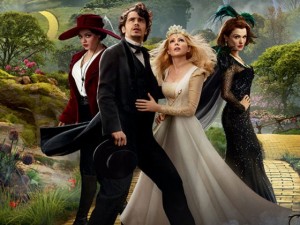 Oz the Great and Powerful is being touted as a “prequel” to the beloved and venerable 1939 MGM musical, The Wizard of Oz. As it turns out, it both is and isn’t; and my reactions to it are similarly divided. I find myself responding to it as a movie, and as a potential contribution to the lore of L. Frank Baum’s fairyland. So, if you ask me (paraphrasing Glinda’s question of Dorothy in the older movie), “Is it a good film, or a bad film?,” I’d have to say… Yes.
Oz the Great and Powerful is being touted as a “prequel” to the beloved and venerable 1939 MGM musical, The Wizard of Oz. As it turns out, it both is and isn’t; and my reactions to it are similarly divided. I find myself responding to it as a movie, and as a potential contribution to the lore of L. Frank Baum’s fairyland. So, if you ask me (paraphrasing Glinda’s question of Dorothy in the older movie), “Is it a good film, or a bad film?,” I’d have to say… Yes.
The Good, the Bad, and the Ozzy
I will assume you’ve seen the movie—if you haven’t, why are you reading a piece labeled as containing spoilers?—and move right to my review. As a movie, Oz is mostly entertaining. If you’re looking for a family-friendly adventure (some intense moments of roaring, rampaging flying baboons and witches tossing CGI-lightning at each other may be too much for the youngest moviegoers) that offers an interesting story competently told, you could do far worse. There is plenty of action, and lots of humor, though some jokes play better than others.
Production values are quite high, as one, of course, expects from a Disney effort. It’s a very pretty film, and even approaches true beauty in places; the bubble ride through the gigantic emerald crystals sticks in my mind as one visual high point. Danny Elfman’s score in isolation (thank you, Spotify) sounds, at least to my ear, just like every Elfman score post-Batman (1989) I’ve ever heard, complete with an overabundance of women singing open vowels; in the context of the movie, however, it works quite nicely. The film’s first fifteen minutes or so, giving us a glimpse of Oscar’s life as a Kansas carnival magician, are also quite well-written and –realized, far more satisfying than the sepia portion of The Wizard of Oz they are meant to complement.
The actors’ performances are serviceable, although none of the human characters are true standouts. Mila Kunis conveys something enough like naïve innocence that we can accept Oscar breaks her heart, although not all the pyrotechnics in Hollywood can help her “sell” her transformation into the Wicked Witch of the West. (Oddly enough, that iconic pose of the Witch amidst swirling flames that you’ve seen in the trailer and commercials? Not in the finished film, to the detriment of Kunis’ character.) Rachel Weisz is either remarkably restrained or bored, depending on your point of view, in her role as Evanora; either way, she doesn’t do as much with her script material as one might wish. As the title character, James Franco is affable, but he seems only slightly more engaged than he did as an Academy Awards host two years ago.
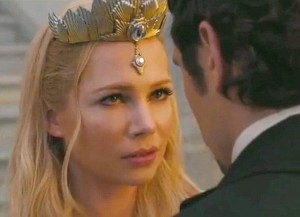 The strongest cast member by far is Michelle Williams as Glinda. Finally, movie audiences have an image of Glinda other than Billie Burke’s nearly insufferable, twittering, taffeta-clad uber-soprano sorceress. Like Burke’s character, Williams’ Glinda also is pretty (as is almost everyone in Oz) and travels via bubble, but she is also resourceful and a canny judge of people. I also found myself believing that she cared for the Munchkins (and, in this version, their fellow fairyland denizens the Quadlings and the Tinkers) as people, not as pets (which is how Burke’s treatment of the 1939 Munchkins always strikes me). When Glinda takes charge of the struggle to liberate Oz (which, alas, isn’t often enough), she delivers a real jolt of life to the film. One of its most satisfying moments occurs when, in response to an airborne Evanora’s taunt, “All out of bubbles?,” Glinda replies, “The bubbles are just for show,” and rises into the air to join battle. Glinda and Evanora’s magical duel is, in fact, the highpoint of the action, almost enough to make me think I was watching a serious fantasy film; it evokes Gandalf and Saruman’s showdown in The Fellowship of the Ring more than a little.
The strongest cast member by far is Michelle Williams as Glinda. Finally, movie audiences have an image of Glinda other than Billie Burke’s nearly insufferable, twittering, taffeta-clad uber-soprano sorceress. Like Burke’s character, Williams’ Glinda also is pretty (as is almost everyone in Oz) and travels via bubble, but she is also resourceful and a canny judge of people. I also found myself believing that she cared for the Munchkins (and, in this version, their fellow fairyland denizens the Quadlings and the Tinkers) as people, not as pets (which is how Burke’s treatment of the 1939 Munchkins always strikes me). When Glinda takes charge of the struggle to liberate Oz (which, alas, isn’t often enough), she delivers a real jolt of life to the film. One of its most satisfying moments occurs when, in response to an airborne Evanora’s taunt, “All out of bubbles?,” Glinda replies, “The bubbles are just for show,” and rises into the air to join battle. Glinda and Evanora’s magical duel is, in fact, the highpoint of the action, almost enough to make me think I was watching a serious fantasy film; it evokes Gandalf and Saruman’s showdown in The Fellowship of the Ring more than a little.
I found Finley the flying monkey (the only one this time around, and still on the “good” side of things) a lot of fun to watch. Zach Braff sounded like he was channeling Billy Crystal a bit too much, but the character is fairly well-developed and is expertly animated. I also liked the China Girl, a great deal; Joey King voices her with both sensitivity and sass, as needed, and she, too, is rendered quite satisfactorily, down to the light crazing that covers her. I enjoyed watching her plead with Oscar to be included on the quest, one of the effortlessly amusing scenes in the film. Besides, it tickled me, as a long-time Ozophile, to see a lesser-known character from Baum’s pages brought to life on the screen.
But when, as an Oz fan, I consider this movie as a contribution to Oz lore, my opinion of it crashes like Dorothy’s house. If you don’t feel personally invested in Oz, I expect you won’t resonate with the rest of this review; you may even think I’m taking the film too seriously. You’d be right, except that—as I wrote for the SFC earlier this week—I’ve seen the magic that can happen when filmmakers do take Oz seriously. I had high hopes that Sam Raimi would; not, obviously, in the same way Walter Murch did in Return to Oz, but in his own way, perhaps as seriously as he had taken Spider-Man in his web-slinger trilogy. True confession: even though I’d seen, in every commercial, the moment in which Oscar’s balloon enters Oz’s airspace, and the movie transitions (a la 1939) from black-and-white to color, I misted up watching it happen just the same. Briefly, I really felt like we’d really entered Oz.
But here’s the problem: Raimi has invested this movie so deeply in the legacy of the 1939 film that he leaves himself little room to create a vision of his own, or to try and cast his own spell over moviegoers. At almost every turn, Raimi’s Oz looks like MGM’s—different enough to avoid copyright or trademark infringement (I guess—if I were an MGM lawyer, I’d be taking a long, hard look at this movie), but not different enough to count as a true attempt at world-building, let alone at evoking what J.R.R. Tolkien called “secondary belief.” Raimi’s Oz feels like Victor Fleming’s, so much so that a scene clearly meant as a good-natured parody of the musical—when the Munchkins arrive and burst into song—feels like the “Ozziest” thing in the whole two hours’ running time.
In Your Dreams?
The visual similarities aren’t the only problem, however. Any attempt to treat this Oz movie with any seriousness as a work of fantasy completely falls apart because Raimi chooses (as, in fairness, Walter Murch chose) to adopt the double-casting route that MGM took in 1939. In other words, the people Oscar meets “in Oz” are thinly veiled versions of the people he knows in Kansas, characters portrayed (or voiced) by the same actors. What does this fact mean except that Oscar’s journey to Oz, like Judy Garland’s Dorothy, is just a dream?
Now, even though relegating Oz to dream status completely flies in the face of any of Baum’s books, the MGM musical at least had the integrity to make the choice and carry it through. Dorothy wakes up. I can’t stand that stupid “And you were there, and you were there” speech that Judy Garland breathlessly delivers, but I will at least concede that it makes good narrative sense. It belongs. It pays off the premise. Dorothy has a dream, she wakes up, she integrates its lessons into her life, and all is well.
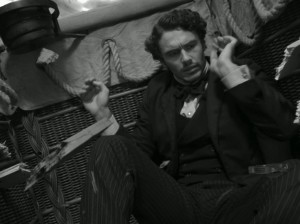 In contrast, Raimi’s story (for the record, the screenplay is by Mitchell Kapner and David Lindsay-Abaire) begins in Kansas but ends in Oz. What are we to make of this fact? We watch Oscar develop as a character (well, ostensibly—more on that in a moment), but why is he seeing the people of Kansas the citizens of Oz? Why does he treat his carnival assistant Frank so badly in our world, but give Finley his everlasting friendship in Oz? Why does he turn down his last chance to pursue his one true love Annie in our world, but embrace Glinda in Oz? Where is the internal logic?
In contrast, Raimi’s story (for the record, the screenplay is by Mitchell Kapner and David Lindsay-Abaire) begins in Kansas but ends in Oz. What are we to make of this fact? We watch Oscar develop as a character (well, ostensibly—more on that in a moment), but why is he seeing the people of Kansas the citizens of Oz? Why does he treat his carnival assistant Frank so badly in our world, but give Finley his everlasting friendship in Oz? Why does he turn down his last chance to pursue his one true love Annie in our world, but embrace Glinda in Oz? Where is the internal logic?
I think this is more than a fannish or just plain finicky point. Again, this film said to be a “prequel” to The Wizard of Oz—but if Oscar’s Oz is not a dream, despite the fact that the movie’s very structure, trading on the 1939 film, leads us to believe it will be, how is it that Dorothy Gale (incidentally, Annie, the woman Oscar lets get away in our world, announces she will be marrying one John Gale instead) dreams almost exactly the same Oz when her tornado hits?
And if Oscar’s Oz is not a dream and, somehow, despite the 1939 film’s complete lack of ambiguity on this point, Dorothy’s Oz is the same Oz, then what happens to Oz in the meantime? No doubt I’m pressing things further than the filmmakers intended (although Disney is already exploring sequel options), but this film ends with Oscar and Glinda together, all set to rule Oz as king and queen; with the Munchkins and the Winkies as free peoples; with Finley as the only winged monkey, also free; and with Oscar having extended the possibility of reconciliation to Theodora, the Wicked Witch of the West. Granted, that last is something Theodora swears will never happen as she zooms off on her broomstick; but Oscar’s attitude, to be consistent with the 1939 film, must somehow shift from being open to reconciliation to demanding that Dorothy and her friends destroy her. Where is Glinda’s good influence then? If this movie is seriously being offered as backstory to the 1939 movie, we have some troubling gaps to fill in.
(Not even L. Frank Baum could rest easy with the idea of the Wizard having a shadowy backstory: in The Marvelous Land of Oz (1904), the series’ second volume, he describes how the Wizard, upon his arrival, arranged for the country’s rightful ruler, the infant Princess Ozma, to be kidnaped and hidden away; but by the time the Wizard returns in Dorothy and the Wizard in Oz (1908), all that has been conveniently forgotten.)
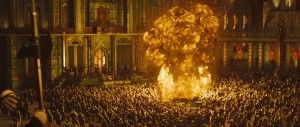 Questions of Oz’s “reality” aside, the fact that the movie ends with Oscar basing his rule of Oz on a lie is troubling in itself. Yes, it’s a clever (if predictable) plot to have him save the Land of Oz through large-scale applications of his carnival magic tricks and turn-of-the-twentieth century show business technology. I did enjoy watching Oscar outwit the witches, as audiences are meant to. But even the slightest reflection on where Oz stands at the film’s end leads too quickly to unappealing conclusions. Oscar and Glinda and the rest of the “inner core” agree to a cover-up, because it’s more important that the people of Oz believe Oscar is their great wizard than know the truth. Oscar anticipates the wicked witches will be back, and decides the only defense is to keep up his “great and powerful” charade. At least this is a point of consistency with the MGM film, but it calls into question whether Oscar really has learned anything, whether he really has grown as a person. When he arrives in Oz, he gets into trouble precisely because he is pretending to be someone he is not. Now, as ruler of Oz—presumably with Glinda, although this development is not explicitly shown (and, if she does become his queen, where has she gone by the time Dorothy shows up, and why?)—he is going to continue to pretend to be someone he is not, for his subjects’ own good? It’s all seems mildly Machiavellian, and that Glinda would endorse such a plan boggles my mind. In the 1939 film, she seems to believe, as does everyone else, that Oz is a wonderful wizard. If we are to believe Raimi’s film, however, she’s the Ozzy equivalent of Obi-Wan Kenobi, sharing things that are true “from a certain point of view.” (Of course, even in the 1939 film, she doesn’t tell Dorothy that those ruby slippers will send her home until she decides the time is right, so maybe a conspiratorial Glinda isn’t that much of a stretch after all. But then again, Dorothy had a dream. Did Oscar?)
Questions of Oz’s “reality” aside, the fact that the movie ends with Oscar basing his rule of Oz on a lie is troubling in itself. Yes, it’s a clever (if predictable) plot to have him save the Land of Oz through large-scale applications of his carnival magic tricks and turn-of-the-twentieth century show business technology. I did enjoy watching Oscar outwit the witches, as audiences are meant to. But even the slightest reflection on where Oz stands at the film’s end leads too quickly to unappealing conclusions. Oscar and Glinda and the rest of the “inner core” agree to a cover-up, because it’s more important that the people of Oz believe Oscar is their great wizard than know the truth. Oscar anticipates the wicked witches will be back, and decides the only defense is to keep up his “great and powerful” charade. At least this is a point of consistency with the MGM film, but it calls into question whether Oscar really has learned anything, whether he really has grown as a person. When he arrives in Oz, he gets into trouble precisely because he is pretending to be someone he is not. Now, as ruler of Oz—presumably with Glinda, although this development is not explicitly shown (and, if she does become his queen, where has she gone by the time Dorothy shows up, and why?)—he is going to continue to pretend to be someone he is not, for his subjects’ own good? It’s all seems mildly Machiavellian, and that Glinda would endorse such a plan boggles my mind. In the 1939 film, she seems to believe, as does everyone else, that Oz is a wonderful wizard. If we are to believe Raimi’s film, however, she’s the Ozzy equivalent of Obi-Wan Kenobi, sharing things that are true “from a certain point of view.” (Of course, even in the 1939 film, she doesn’t tell Dorothy that those ruby slippers will send her home until she decides the time is right, so maybe a conspiratorial Glinda isn’t that much of a stretch after all. But then again, Dorothy had a dream. Did Oscar?)
A Woman’s Place?
One last question I feel I should address was raised by Elisabeth Rappe at Film.com in an editorial entitled, “Why Oz the Great and Powerful Is A Major Step Back For Witches and Women.” Rappe writes:
In a bitter reversal of Baum’s stories, Great and Powerful casts the women as the sidekicks, standing by to aid the Wizard should he need it. No longer instigators of action, the witches Glinda, Theodora, and Evanora now clasp their hands at [his] arrival, thrilled the prophesied hero has… Who knew three sorceresses—who were all-seeing and all-knowing in prior Oz tales—were actually helpless compared to a man from Kansas?… Great and Powerful corrects Baum’s grievous abstinence, and reminds us all women must fall for a handsome traveler. The modern day Wizard now wins at least 2/3 of the onscreen hearts instead of being shamed as a liar.
When a friend pointed out this article on Facebook before I saw the film, I reacted rather defensively (as Facebook makes it too easy to do). I’d been looking forward to this movie for many months, darn it, and I was going to give it a fair chance!
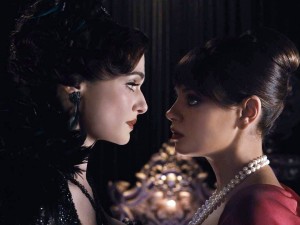 Well, having seen the film, I can now say you don’t have to be consciously attempting any feminist reading of it to realize that Rappe makes a convincing case. The prophecy surrounding the Wizard’s arrival is never satisfactorily explained (as male friends with whom I saw the film pointed out), and I found myself wondering exactly why Glinda needed this man, or any man, to rally the people of Oz into an army. Again, Michelle Williams gives us a fairly compelling character, one who seems like she could easily inspire Oz’s denizens to fight for their freedom (although, as one of those friends I went to the movie with also pointed out, we are never shown exactly how Evanora is oppressing Oz; we are simply told that she is, and that she is wicked—she even tells us herself).
Well, having seen the film, I can now say you don’t have to be consciously attempting any feminist reading of it to realize that Rappe makes a convincing case. The prophecy surrounding the Wizard’s arrival is never satisfactorily explained (as male friends with whom I saw the film pointed out), and I found myself wondering exactly why Glinda needed this man, or any man, to rally the people of Oz into an army. Again, Michelle Williams gives us a fairly compelling character, one who seems like she could easily inspire Oz’s denizens to fight for their freedom (although, as one of those friends I went to the movie with also pointed out, we are never shown exactly how Evanora is oppressing Oz; we are simply told that she is, and that she is wicked—she even tells us herself).
Again, it may seem silly to spend such time and energy critiquing what is surely intended as no more than a fun story. But, as we talk about time and again here at the SFC, stories matter, and some stories are better than others. Some stories lift up and celebrate “whatever is true… honorable… just… pure… pleasing… commendable… [and] worthy of praise” more than others (Phil. 3.8, NRSV). Some stories glorify the God who created both male and female in the divine image more than others. So a story that is largely about women fighting over a man, a man who creates and reinforces his authority through deception, seems suspect at best, not from any “politically correct” or “feminist” perspective, but simply from a Christian one. As I’ve said in this forum before, “stereotypes ultimately limit and diminish us all,” and God’s people have the responsibility of exposing them where we find them—even in Oz. (By the way, this strikes me as one more reason the filmmakers should have stuck to their opening gambit and made Oscar’s Oz-experience a dream: at least then, though the unequal gender relationships would’ve still been present, one could say, “Well, of course, since the story was just Oscar working out his issues in his own dream!”)
Sadly, Hollywood tried, in 1985, to give us L. Frank Baum’s Oz, where stereotyped male-female relationships don’t muddy the waters, and where heroines lead the way. Audiences roundly rejected Return to Oz, and that movie’s prospects for popular rehabilitation seem dim, to say the least. As of this writing, Oz the Great and Powerful is forecast to have “the strongest debut of the year so far,” conjuring $70 million or more; and it’s enjoying an 82% approval rating at Rotten Tomatoes.
When folks go off to see the Wizard now, no doubt they’ll still run first to the 1939 classic—nothing will ever displace it as the general public’s Ozzy standard—but Great and Powerful will wield exactly that kind of influence over the popular imagination for years to come, until some other filmmaker decides to be brave and go back to the sources to craft a new vision of that land we’ve all heard of, once, in a lullaby.

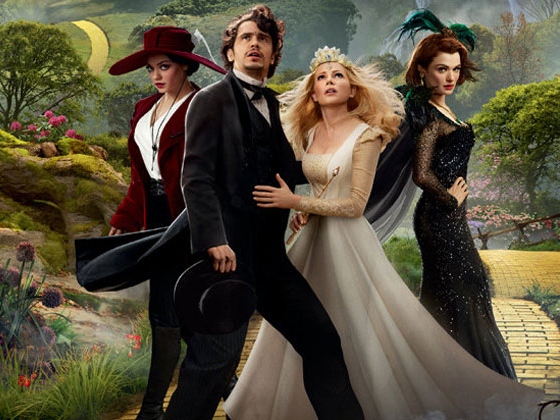
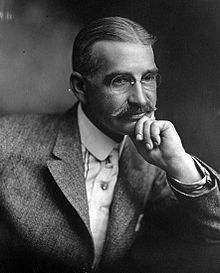
One comment on ““Oz the Great and Powerful”: One Sci-Fi Christian’s First Reactions (With Spoilers)”